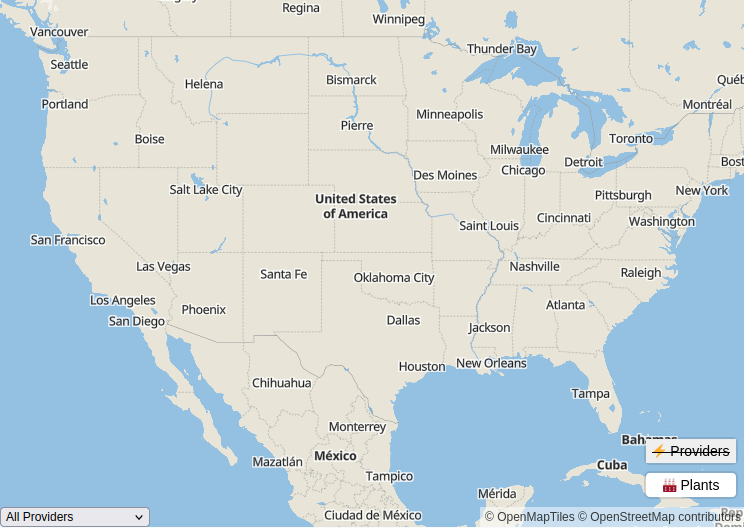Nebraska Public Power District
Electricity Rates, Plans & Statistics
Can You Save With Wind?
You’ve heard of solar, but did you know that you can power your home and business with wind?
About Nebraska Public Power District
Nebraska Public Power District is a political subdivision supplying electricity in 2 states in the US including Nebraska and South Dakota. The average residential electricity price for Nebraska Public Power District is around 10.60 cents per kilowatt hour, resulting in the provider ranking 491st out of 2893 in the nation. There were a total of 4,091,399 megawatt hours sold via retail sales in 2022 by the provider. The electricity generated in the company's power plants made up 14,649,116 of the megawatt hours sourced by the company and the purchase of wholesale electricity made up an additional 5,093,633 megawatt hours. Nebraska Public Power District had $1,154,371,000 in 2022. Exactly $792,507,000 of that revenue came from wholesale electricity sales and $268,061,000 came from sales to residential electricity customers.
Customers of the supplier have an average monthly residential power bill of $100.88. This is 25.48% lower than the United States average bill of $135.38. The company's generating facilities produce 459,978.65 megawatt hours from natural gas. This amount makes them 189th highest in the country out of 3517 suppliers for total natural gas generation. The provider ranks 130th in the United States for megawatt hours generated from solar energy sources. Electricity generation from renewable fuel types by the supplier totals 152,389 megawatt hours, ranking the supplier 173rd in the country out of the 3517 we track.
Consumers of Nebraska Public Power District are able to take advantage of net metering solutions, which is a positive for both parties. Net metering makes solar panel purchases more economically feasible as it gives the ability for consumers to sell electricity back to the grid.
Nebraska Public Power District currently has a loss of roughly 3.99% of the electricity that they produce. This percentage of loss gives them a ranking of 617th best out of 3517 providers who report energy loss in the US.
Nebraska Public Power District Rate & Electric Bills
Nebraska Public Power District residential electric rates are highest in January and the highest average bill is in February.
Historical Electricity Rates:
You’ve heard of solar, but did you know that you can power your home and business with wind?
Nebraska Public Power District Overview
- Company Type:Political Subdivision
- Headquarters:1414 15th Street
Columbus, Nebraska 68602
United States of America - CEO:Tom Kent
Nebraska Public Power District Contact
- Website:www.nppd.com
- Customer Service Phone:(877) 275-6773
- Contact Page:www.nppd.com
- Social Media:
Nebraska Public Power District Service
- Rates & Plans:www.nppd.com
- Outage Map:onlineaccount.nppd.com
- States Served:
- Nebraska
- South Dakota
- Counties Served:
- Buffalo County
- Scotts Bluff County
- Madison County
- Lincoln County
- Cass County
- Major Cities Served:See all cities
- Table Of Contents:
Quick Facts About Nebraska Public Power District
Nebraska Public Power District is 4th in the state out of 150 electric suppliers for total megawatt hours produced from hydroelectric power.
Nebraska Public Power District produces 89,103 megawatt hours of electricity (or 0.56% of their total electricity production) from wind turbines.
Nebraska Public Power District is the largest producer of megawatt hours from non-renewable fuels in Nebraska.
As the 83rd largest generator of electricity in the country, Nebraska Public Power District produces 15,857,345.99 megawatt hours of electricity.
Nebraska Public Power District is 1st out of 150 electric suppliers in the state in megawatt hours generated from coal use.
Nebraska Public Power District produces 43.79% of their megawatt hour production from nuclear power sources, for a total of 6,943,760 megawatt hours generated from nuclear.

Energy Loss
Nebraska Public Power District's energy loss due to business operations.
Total Energy Loss
788,048MWh
617 National Rank
Nebraska Public Power District Energy Makeup
You’ve heard of solar, but did you know that you can power your home and business with wind?
Nebraska Public Power District Coverage Map

Nebraska Public Power District State Coverage
| State | Customers | Sales ($) | State Rank Based On Revenue | % of Provider's Residential Sales in State |
|---|---|---|---|---|
| Nebraska | 92,629 | 262,789,535 | 3 | 98.24% |
| South Dakota | 1,286 | 3,012,556 | 49 | 1.76% |
Nebraska Public Power District County Coverage
| County | Population | Providers | Avg. County Rate (¢) | Avg. Electric Bill |
|---|---|---|---|---|
| Boyd County | 1,812 | 3 | 10.58 | $138.54/mo |
| Buffalo County | 49,840 | 3 | 11.23 | $146.01/mo |
| Burt County | 6,705 | 3 | 13.30 | $217.44/mo |
| Cass County | 26,546 | 3 | 12.03 | $110.07/mo |
| Dakota County | 21,284 | 3 | 9.32 | $128.52/mo |
| Dawes County | 8,383 | 2 | 13.00 | $198.92/mo |
| Deuel County | 1,878 | 4 | 12.86 | $138.60/mo |
| Fillmore County | 5,561 | 5 | 10.63 | $184.65/mo |
| Hamilton County | 9,376 | 5 | 9.21 | $124.59/mo |
| Johnson County | 5,298 | 3 | 12.12 | $110.35/mo |
Power Plants Owned by Nebraska Public Power District
| Plant | City/County | State | Primary Fuel Type | Production (MWh) | Emission (kg) | Emissions/MWh | Toxic Chemical Release | Closing Date |
|---|---|---|---|---|---|---|---|---|
Gerald GentlemanNebraska Public Power District (100.00%) | Lincoln County | NE | Coal | 7,613,828.99 | 7,377,275,607.63 | 968.93 | ||
Cooper Nuclear StationNebraska Public Power District (100.00%) | Nemaha County | NE | Nuclear | 6,943,760 | ||||
| Lancaster County | NE | Coal | 715,932 | 812,714,690.95 | 1,135.18 | |||
| Gage County | NE | Natural Gas | 402,806 | 182,526,771.42 | 453.14 | |||
Ainsworth WindNebraska Public Power District (100.00%) | Brown County | NE | Wind | 89,103 | ||||
North PlatteNebraska Public Power District (100.00%) | Lincoln County | NE | Conventional Hydroelectric | 50,455 | ||||
| Gosper County | NE | Natural Gas | 21,993 | 14,501,881.66 | 659.39 | |||
Kearney NPPD Solar ProjectNebraska Public Power District (100.00%) | Buffalo County | NE | Solar | 12,456 | ||||
| McCook | NE | Distillate Fuel Oil | 2,430 | 2,306,277.87 | 949.09 | |||
| Thayer County | NE | Distillate Fuel Oil | 2,379 | 2,209,006.89 | 928.54 |
Nebraska Public Power District Fuel Makeup
Cities Nebraska Public Power District Has Coverage
- Ainsworth, NE
- Alma, NE
- Anoka, NE
- Ashton, NE
- Atkinson, NE
- Aurora, NE
- Barada, NE
- Bassett, NE
- Big Springs, NE
- Bloomfield, NE
- Bridgeport, NE
- Bristow, NE
- Broadwater, NE
- Brule, NE
- Burchard, NE
- Butte, NE
- Chadron, NE
- Clinton, NE
- Crab Orchard, NE
- Craig, NE
- Crawford, NE
- Creighton, NE
- Dakota City, NE
- Dawson, NE
- Du Bois, NE
- Elm Creek, NE
- Elsie, NE
- Emmet, NE
- Geneva, NE
- Gering, NE
- Gibbon, NE
- Gordon, NE
- Hartington, NE
- Hay Springs, NE
- Homer, NE
- Humboldt, NE
- Inman, NE
- Kearney, NE
- Lewellen, NE
- Lewiston, NE
- Long Pine, NE
- Loup City, NE
- Lynch, NE
- Madrid, NE
- McCook, NE
- McGrew, NE
- Meadow Grove, NE
- Melbeta, NE
- Merriman, NE
- Milford, NE
- Minatare, NE
- Murray, NE
- Nehawka, NE
- Norfolk, NE
- O'Neill, NE
- Oakdale, NE
- Oakland, NE
- Ogallala, NE
- Oshkosh, NE
- Pawnee City, NE
- Plattsmouth, NE
- Ravenna, NE
- Rushville, NE
- Scottsbluff, NE
- Shelton, NE
- Shubert, NE
- South Sioux City, NE
- Steinauer, NE
- Stella, NE
- Sterling, NE
- Sutherland, NE
- Table Rock, NE
- Tekamah, NE
- Terrytown, NE
- Tilden, NE
- Union, NE
- Venango, NE
- Verdon, NE
- Whitney, NE
- Winnebago, NE
- York, NE
* City coverage generated based on government data. Always verify you can get service from the provider.
Nebraska Public Power District Reviews
Write a Review of Nebraska Public Power District
Nebraska Public Power District FAQ:
Who is the CEO of Nebraska Public Power District?
The current CEO of Nebraska Public Power District is Tom Kent.
What is the average bundled bill for Nebraska Public Power District customers each month?
Nebraska Public Power District currently has an average monthly bundled electric bill of $100.88, compared to the US of $135.38 for bundled service.
What percentage of Nebraska Public Power District's electricity is produced using renewable fuel sources?
Power facilities owned by or associated with Nebraska Public Power District produce 0.96% of their electricity using renewable fuel sources.
How many power plants are owned by or associated with Nebraska Public Power District?
Nebraska Public Power District owns or is associated with 13 power plants.
What is the phone number for Nebraska Public Power District?
You can reach Nebraska Public Power District by phone via (877) 275-6773.
What is the average BUNDLED electricity rate for Nebraska Public Power District customers?
Customers of Nebraska Public Power District, on average, have an electricity BUNDLED rate 10.60 cents per kilowatt hour (¢/kWh).
What percentage of Nebraska Public Power District's electricity is generated from nonrenewable fuels?
Nebraska Public Power District produces 99.04% of their electricity from nonrenewable fuel types.
How many states does Nebraska Public Power District sell electricity in?
There are 2 states that receive at least some electricity coverage by Nebraska Public Power District.
What cities does Nebraska Public Power District provider electricity in?
Nebraska Public Power District has customers in 81 cities.
How many counties does Nebraska Public Power District supply electricity to?
Nebraska Public Power District provides electricity in 21 counties.